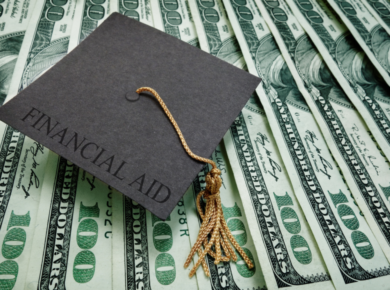If you have student loans but are finding it hard to make your monthly payments know that you are not alone. From a study completed in 2018, it was found that of the 7095 participants surveyed, 88% of borrowers are struggling to make their monthly payments. A majority of participants reported having a high debt to income ratio.
Just starting with student loans? The Dos And Don’ts Of Student Loan Repayment
The average total debt landed around $87,500, while the average yearly income was only $60,000. It is easy to understand why the national student debt total is in the trillions. While there is comfort in knowing that you aren’t the only one struggling, that doesn’t solve the issue at hand. If your loans are currently delinquent or defaulted and you are looking for some guidance, you are in the right place.
Table of Contents
The first step when dealing with student loans is to understand what kind you have. Options for resolving a delinquency or default status will vary if your loans were federally or privately funded. If you are unsure what type of loans you have, try checking the National Student Loan Data System (NSLDS). This is a database managed by the Department of Education for federal student loans. If you can see your loans in the system, then you have federal loans.
You will also be able to see the information for the lender servicing your loans and your loan status. If you are unable to see any loans but know that you have loans taken out, then that is a good indicator that you have private loans. Keep in mind, it is possible to have both federal and private loans. What you are seeing in NSLDS might not be all of your loans. Reach out to your previous institution if you are still unsure which types of loans you were using.
Federal Loans
If you are unable to make payments on your federal student loans the account will move into a delinquency status. This will happen right away, but the delinquency is not typically reported to crediting agencies until 30 days after the first missed payment.
So, if you missed the payment in error or were able to come up with funds quickly, make sure to get the payment made as soon as possible. Otherwise, if you are dealing with an economic hardship that is temporarily preventing you from making payments, you may qualify for a deferment or forbearance.
Deferments
Both options allow you to temporarily stop making payments. However, deferments are a slightly superior option. During a deferment you would not be held responsible for any interest that accrues on subsidized or Perkins loans (these are need-based loans that were offered by the Department of Education until 2017).
Unfortunately, all other forms of federal loans like unsubsidized and PLUS loans, would continue to accrue interest. The qualifying factors for receiving a deferment are limited, so it can be difficult to receive approval. Examples of qualifying criteria would be:
- Returning to school as a full-time student
- Being enrolled in an approved Graduate Fellowship or Rehabilitation Training Program
- Unemployment or the inability to find full-time employment
- Facing severe economic hardship
- Active duty military or active Peace Corps service
If you feel like you qualify for any of these options you would need to submit the appropriate form to your lender servicer. Approval will be at the servicer’s discretion.
Request Forbearance
For borrowers who are unable to qualify for a deferment, the next option would be to request forbearance. Just like a deferment, forbearances must be formally requested. During a forbearance all of your federal loans will continue to accrue interest, but the approval criteria is less strict. There are two types of forbearance approvals: general and mandatory. General forbearance approval can be granted for many reasons. It is at the discretion of the servicer to determine if your current situation qualifies for forbearance. General examples of qualifying reasons are:
- Medical expenses
- Loss of income
- Basic financial hardship
Alternatively, during a mandatory forbearance, the servicer is required to approve it if you can show proof that you meet the requirements. The criteria for approval are much less vague and outline very specific circumstances. You can review all of the criteria on the Federal Student Aid website.
One of the most common approval criteria is income to debt ratio. If it can be determined that your monthly student loan payments total more than 20% of your monthly income, then you would qualify for a mandatory forbearance. Both types of forbearance can only be approved for one year at a time. At the end of the year, you would need to resubmit your request for forbearance.
Although deferment and forbearance are much better options than defaulting on a loan, keep in mind that they are not necessarily the best options. Even though you are not required to make payments, your loans could still be accruing interest and your balance could grow each day.
Deferment and forbearance should be used as a short-term solution. You should set a deadline for how long you are comfortable halting payments and work towards getting back to your normal payment schedule by that date. If you hit the deadline and are still facing financial hardships, it may be more beneficial to request approval for an income-based repayment plan.
Depending on your income and house size, your monthly payment could be as low as $0 per month (no, that is not a typo it really can be that low). This is beneficial because income-based repayment plans are set for a certain repayment period. Depending on the repayment plan that you are approved for, the repayment timeframe would be either 20 or 25 years. After that time, any remaining balance will be forgiven if consistent payments were made during the repayment period.
Obviously, it is within the benefit of the borrower to start working towards the 20-25 year timeframe as soon as possible. This is especially true if you can have a small monthly payment that works in your budget. I encourage all borrowers to reach out to their servicers to review all available options to determine what would be best.
Default Status
The reality for many borrowers is that they have already entered a default status on their federal loans and are unsure what the next steps should be. Once this happens, it can be easier to just ignore the debt and hope that the collection agencies stop calling. Unfortunately, that will never be the case. Defaulted student loans will continue to follow you, they will damage your credit, and they are almost impossible to settle via a bankruptcy. Because the loans are federally controlled, it is possible to have your wages garnished and to have government payments (like tax-returns) withheld.
You are also prevented from taking out additional federal financial aid. So, if you still need to complete some of your courses, the default could stand in the way. Once loans have fallen into a default status, there are 3 steps that can be taken to remove the default: payment in full, loan rehabilitation, or loan consolidation.
Payment in full is exactly as it sounds. You would make one lump sum payment to resolve the loans all at once. Clearly this is an ideal solution since the loan amount and all interest accrued become immediately due once a loan enters into default. In reality, paying in full is not a valid option for most people who are facing default. However, if your loan amounts are relatively small or if you receive new funds from an inheritance or gift, full repayment should be considered.
How To Get Help With Your Student Loan In Default
For most borrowers, the best options will be either loan rehabilitation or loan consolidation. Both will bring the loan out of default, but they have some differences in qualification criteria. Also, rehabilitation and consolidation can each only be done once. Therefore, it is important to prevent the loans from going back into default once they have been taken out of it.
Student Loan Rehabilitation
For loan rehabilitation, the borrower must agree to make 9 consecutive payments on their loan within a 10-month period. Payments can be no more than 20 days past the due date to be considered consecutive. Rehabilitation only applies to one loan at a time. So, if you have multiple loans you would need to apply for rehabilitation for each loan separately.
The lender will determine your monthly payment by first calculating your annual discretionary income. Discretionary income is anything in your annual income over 1.5 times the poverty level for your location and family size. Annual discretionary income divided by 12 determines your monthly discretionary income. Your payment will be 15% of your monthly discretionary income. If you are unable to afford the 15%, you can request that the servicer base your payments off of your total monthly income minus your current expenses. It is possible for your monthly payments to be as low as $5 per month.
Once the 9 consecutive payments have been made, your default will be fully resolved and will be removed from your credit history. Unfortunately, it is possible to still be contacted by collection agencies during rehabilitation due to the lengthiness of the process. Once the rehabilitation is complete, you are eligible to receive federal financial aid again.
You are also eligible to move your loans back into a forbearance or deferment status if you are unable to continue to make the monthly payments. However, as discussed previously, depending on the length of your financial hardship it may be best to speak to the lender about lowering your monthly payments, rather than switching to deferment or forbearance.
Student Loan Consolidation
The other option is to apply for loan consolidation. During loan consolidation, your loans are combined into one single loan through one servicer. This is positive since moving forward you will only need to make one monthly payment. Unfortunately, your principal and interest from the defaulted loans will be transferred to the full principal loan amount once consolidated. Because of this, your interest may accrue more quickly since your principal amount is higher.
In order to qualify for consolidation, there are two options. The first option is to make 3 consecutive payments on your current loans prior to consolidation going into effect. If your default has caused your wages to be garnished or your payments are being made due to a court order, those mandates must be lifted before the consolidation can occur. If you choose to make the 3 payments prior to consolidating, you are able to choose any repayment plan that you feel is best for you. You can work with the servicer to determine an amount that is reasonable for your financial situation.
If you are unable to agree to the monthly payments, the other option is to consolidate the loans under an income-driven repayment plan. The payments will be based on your income minus expenses and would carry positive loan repayment options. Similar to rehabilitation, once a loan is consolidated you are eligible for federal financial aid again and can request to have the loans placed into forbearance or deferment if needed. If you were previously being contacted by collection agencies for your defaulted loans that should stop after the 30-day consolidation timeframe. However, this does not remove the default from your credit report like rehabilitation does.
Lastly, consolidation is a process that happens directly between you and the servicer. You should not need to go through a consolidation company or pay any 3rd parties to assist in the process. If anyone contacts you or offers to process your consolidation for a fee, reach out to your servicer first. You can accomplish everything that you need to do without any outside assistance and can use that money towards your loan payment.
Dealing With Private loans
Unfortunately, resolving a defaulted private loan can be a little bit more difficult. Even though the loans were used for educational expenses, private lenders do not have the same regulations that federal lenders do. Federal lenders are required to have default recovery programs, which is why loan rehabilitation and consolidation are recommended so often.
If you have private loans I encourage you to be exceptionally careful to keep them from going into default. I also discourage you from combining your private and federal loans. Some borrowers will do this through a refinancing process in order to get a lower interest rate. However, once all of your loans are refinanced through a private lender you no longer have access to any of the benefits from a federal loan.
One important distinction for private loans is that they will go into default as soon as you have one missed payment. They do not have an option to move to delinquency status for 9 months like federal loans. If you miss a payment it is important to reach out to your lender as soon as possible. Some private lenders do have programs to help you get back on track, but those options usually expire after 120 days. Then, the defaulted loan is typically moved to a collection agency where they will begin their processes for recovering the funds.
Although collection agencies cannot garnish your wages or withhold government funding, they can still be a pain to deal with. It’s no secret that collection agencies can be very persistent and have many different tactics for getting in contact with you. Even so, remember that you have rights as a borrower and should never feel harassed by creditors or collection agencies. If a collection agency is calling excessively, using obscene language, threatening harm, or any other actions that you feel would constitute as harassment, you can reach out to the Consumer Financial Protection Bureau.
Regardless of the type of loan that you have, the best option for resolving a default is to work with your lender. Understand that in this situation, time is not on your side. The sooner you can make contact, the better. Do your best to understand the different types of loans that you have so that you can make an informed decision when creating a default recovery plan. Also, be realistic with the servicer when discussing your current and projected financial situations. While being in default is never ideal, it can be resolved.




